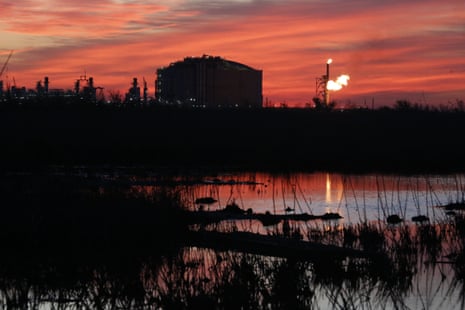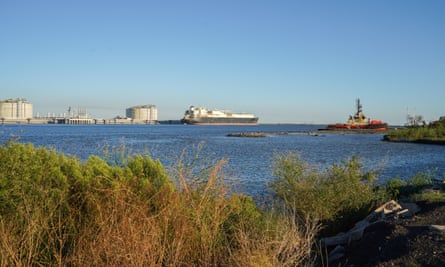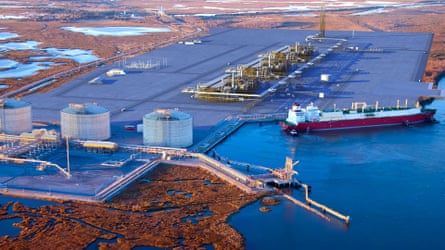"Ukraine is a false justification": America’s destructive new rush for natural gas
Analysis by The Guardian
WORLD 20 March 2023 - 22:00
The Guardian has published an article arguing that as the war in Ukraine sent natural gas prices skyrocketing, liquid natural gas (LNG) plants are springing up all along the fragile Gulf Coast – seriously harming not just local communities but the world’s ability to keep the entire climate crisis at bay. Caliber.Az reprints the article.
About 30 miles south of New Orleans, a construction site visible from space is rising. Sandwiched between the Mississippi River and disappearing wetlands, the 256-hectare (632-acre) site is visited by a stream of tipper trucks and concrete mixers that stir up dust on Louisiana 23, the state highway that goes down to Venice, the last spot of land before the river’s water flows into the Gulf of Mexico.
The wetlands protect the area from hurricane surge and provide critical habitat for fisheries. But when completed in 2025, the construction site here will host a series of tanks and pipes designed for one purpose: to supercool natural gas into liquid form, so it can be transported on giant tankers to sell around the world to the highest bidder.
The Plaquemines liquefied natural gas (LNG) export terminal is just one of five such terminals being built or expanded along the US Gulf coast in Louisiana and Texas. Eight more projects have been approved, and another eight have been proposed – all in a stretch of roughly 700 miles, and where five plants are already operating. If all the new terminals were built, they would double or even triple current US capacity to deliver natural gas – an amount of fuel that, if burned, would contribute to the world tipping over the emissions target required to keep global heating in check.
The economic justification for building all of these terminals was turbocharged by the war in Ukraine, which doubled the price of LNG. According to one analyst’s calculations, last year a single shipload of LNG on the spot market could have earned a profit of up to $200m. The high prices led to a rush of development. It has been forecasted that $42bn in LNG infrastructure will be built worldwide next year – up from $2bn in 2020.
But an unexpectedly mild winter in Europe and lower demand from Asia have tempered enthusiasm for the fuel, with a shipload now expected to earn about $37m profit, according to Seb Kennedy, head of data insights at TransitionZero. That’s still high enough to keep players such as Pakistan, which was outbid by European countries last year, out of the market: the country recently announced that because of the high price of LNG it would stop building natural gas power plants and instead quadruple its number of coal-fired plants.
Meanwhile, even before it has been built, Plaquemines LNG has asked the Federal Energy Regulatory Commission (Ferc) – the agency responsible for energy permits – for permission to increase production, and last week said it had financing to start a second phase of building. This has led a major energy thinktank to warn Ferc that the company’s calculations overestimated future demand for the fuel, and underestimated its carbon emissions.
“We see a scenario on the horizon where natural gas prices and the need for LNG export terminals could decrease,” writes Trey Cowan at the Institute for Energy Economics and Financial Analysis.
Despite the current enthusiasm for LNG, next year may be the last that the number of LNG terminal projects of any size will move forward, as global appetite for natural gas is expected to fall.

“Project approvals after 2024 are forecast to fall off a cliff as governments transition away from fossil fuels and accelerate investments in low-carbon energy infrastructure,” analysts at Rystad Energy write.
Until then, however, Rystad expects investment to soar. If all of the new LNG capacity is built, it would eventually increase annual worldwide capacity from 380m metric tonnes to 705m metric tonnes tonnes , consume 10% of the world’s remaining carbon budget under the Paris Climate Agreement, and seriously kneecap efforts to keep the climate crisis in check.
In a recent report, researchers for the Climate Action Tracker, an independent scientific project that monitors governments worldwide, warn: “This reaction to the energy crisis is an overreach that must be scaled back. As the world’s largest oil and gas producer, the US should show the way beyond fossil fuel extraction – but unfortunately it is now doing exactly the opposite.”
"Optics" and the war in Ukraine
After Russia invaded Ukraine, the Biden administration committed to supply Europe with natural gas to replace Russian supplies. By expediting permits, it allowed US companies to secure at least 19 agreements to supply LNG, according to the Environmental Integrity Project, a US-based watchdog. The moves were so effective that more gas was delivered than had been initially promised.

But the gas that helped Europe through this past winter didn’t come from new terminals. None of the new projects is even operational yet – the first will come online next year at the earliest. Instead, Europe’s new gas supplies came from existing LNG terminals, in the US and elsewhere, which rerouted tankers to Europe. Research from Columbia University suggests the main buyer of new American LNG will be, as it was before, Asia.
Indeed, of the 19 new agreements since the Ukraine war began, fewer than one third are for Europe. And Europe’s need could be short-lived. With Russian supplies cut off, the European Commission has increased its targets for renewable energy to wean Europe Union countries off gas: it now aims to get 45% of EU energy from renewable sources by 2030, more than double the amount today.
“It’s all optics,” says Naomi Yoder of Healthy Gulf, an environmental group focused on the impact of extractive industries across the Gulf of Mexico. “There’s a lot of bluster [about] what is needed in the world in terms of LNG. A lot of that bluster is being focused on the war in Ukraine. It’s really like a false justification.”
Absolutely a sacrifice zone
The LNG industry has chosen the Gulf Coast for several reasons. “The area offers robust natural gas infrastructure located close to prolific natural gas supply, along with deepwater ports, and is well positioned to meet global demand for more US LNG,” says Charlie Riedl, the executive director for the Center for Liquefied Natural Gas.
Analysts, however, note another less frequently cited reason. “The Gulf Coast offers the friendliest regulatory environment,” says Lindsay Schneider at RBN Energy. The result, she writes in a briefing, is the flurry of new plants concentrated “in a very small geographic footprint. It’s an almost unthinkable amount of LNG.”

Despite the east coast’s proximity to Europe making it an ideal candidate for LNG exports, there are only two relatively small terminals so far, in Maryland and Georgia – though there have been proposals for sites in New Jersey and Pennsylvania. On the west coast, one LNG export terminal planned for Oregon was defeated after a years-long battle by environmental groups, landowners and Native Americans. A larger export facility in Alaska had been approved by the federal government, with the backing of the governor, but lost the support of major oil corporations in 2016 and has been making progress slowly ever since.
By contrast, the Democrat governor of Louisiana, John Bel Edwards, has welcomed development there. “The long-term prospects for the US natural gas industry are bright, and Louisiana is well positioned to capitalise on that success, with ready access to natural gas supplies and deepwater access for shipping LNG to destinations worldwide,” Edwards said when the Plaquemines facility was announced in 2017.
He was lauded in turn by energy executives last September at a meeting with Shell, Cheniere Energy and other fossil fuel behemoths. “When it comes to American liquefied natural gas, governor Edwards and Louisiana economic development leaders clearly appreciate LNG’s vital global energy security and environmental benefits and the importance to Louisiana’s economy,” said Corey Grindal, Cheniere’s executive vice-president of worldwide trading. “We appreciate the governor’s interest in the critical role that Cheniere and Louisiana play in the global energy landscape.”
John Allaire, a retired engineer with BP who lives near one of the plants and now works with environmental groups, puts it another way. The Gulf Coast, he says, “is absolutely a sacrifice zone”.

Environmental justice
LNG terminals don’t just change the climate equation. They can have huge impacts on local communities. The ones being built in and around Lake Charles, Louisiana, are already affecting fisheries, while a proposed facility in Brownsville, Texas could get the go-ahead to build as soon as this month on a stretch of unspoilt wetland. Last year, at a terminal in Freeport, Texas, a natural gas vapour cloud exploded, causing widespread alarm.
Plaquemines LNG is no different. Its Deer Range Lake location floods regularly, most recently in 2021 during Hurricane Ida. A recent report from the Sierra Club, an influential US environmental group, showed that the eight-metre (26ft) levees being built around the new terminal would not have prevented the hurricane from flooding it. The area is also prone to subsidence, and a huge plant would probably cause land to sink even faster than surrounding areas, the report found.

Three environmental groups sued the state last year, citing the risk of flooding and the project’s potential impact on the community to argue that it should not move forward – but last week a state judge dismissed the suit.
The environmental effects are already being felt through construction traffic and air pollution. Mark Juengling, a property owner near the Plaquemines plant, said recently in a formal complaint to Ferc: “We now have an LNG plant that could produce hazardous fumes or worse yet if an explosion occurs. That danger is always at the back of our minds now.”
The owner of the Plaquemines plant, Venture Global, did not respond to a request for comment.
Tyson Slocum, the director of energy for Public Citizen, a non-profit consumer advocacy organisation, says that under federal law, gas can only be exported if it has a net benefit to the public. Slocum argues there is no benefit.
“We all want to help our allies in need,” he said. “But it cannot come at the expense of environmental justice.”
Caliber.Az
|
1
|
Armenia returns four villages to Azerbaijan, paving the way for peace in the South Caucasus Landmark accord
23 April 2024 - 09:14
|
|
2
|
Armenian PM's Moscow visit sparks speculation on bilateral relations Dilemma between East, West
23 April 2024 - 11:19
|
|
3
|
Air France plane safely evacuated at Heydar Aliyev Int’l Airport
24 April 2024 - 19:08
|
|
4
|
Bilateral relations, regional dynamics, & peacekeepers’ withdrawal Key takeaways from President Aliyev's Moscow visit
24 April 2024 - 14:07
|
|
5
|
Gulf – Central Asian partnership is on the rise Global uncertainty
22 April 2024 - 16:55
|
Media: US sends long-range ATACMS missiles to Ukraine
25 April 2024 - 10:38
Georgia's pre-election turmoil
How the Law on Foreign Agents shapes voter sentiment?25 April 2024 - 10:27
India stands for closer cooperation in fight against terrorism at BRICS meeting
25 April 2024 - 10:25
Iranian president urges international courts to punish Israel for Gaza Strip operation
25 April 2024 - 10:09
Azerbaijan submits report on Convention Against Torture to UN
25 April 2024 - 09:55
Azerbaijan, Kyrgyzstan sign Memorandum on Cooperation in religious sphere
25 April 2024 - 09:43
US welcomes start of Azerbaijan-Armenia border delimitation process
25 April 2024 - 09:21
PM vows to boost UK defence spending to 2.5% of GDP by 2030
25 April 2024 - 09:07
Azerbaijani, Turkish communities hold rally against fictitious Armenian genocide in Washington
PHOTO25 April 2024 - 09:00
EU’s 2050 net zero goals at risk as electric vehicle rollout faces setbacks
25 April 2024 - 07:03
World’s largest wealth fund issues inflation warning on hot commodity markets
real wildcard25 April 2024 - 05:04
How US F-16 fighter jets stack up to Su-35s sent to Iran?
25 April 2024 - 03:05
Belgian brewer whose body produces its own alcohol cleared of drink driving
25 April 2024 - 01:03
Milan becomes latest European hotspot to battle overtourism
No ice cream and pizza after midnight24 April 2024 - 23:00
Germany's position on Taurus remains unchanged
24 April 2024 - 20:59
German business activity increasing in April
24 April 2024 - 20:48
Baku to host space technology conf for Central Asian region
24 April 2024 - 20:45
Sweden’s plan for worst-case scenario
War spreading in Europe24 April 2024 - 20:40
President’s special rep: Karabakh can be called eco-region of Azerbaijan
24 April 2024 - 20:32
Azerbaijani energy minister holds talks with Algerian delegation on advancing bilateral cooperation
24 April 2024 - 20:28
China's Xiaomi selling more EVs than expected
raising hopes it can break even sooner24 April 2024 - 20:24
France proposes new EU sanctions to fight Russian disinformation
24 April 2024 - 20:18
European Commission disburses additional $1.6 billion in bridge financing to Ukraine
24 April 2024 - 20:16
Serb Member of Presidency of Bosnia & Herzegovina Željka Cvijanović invited to COP29
24 April 2024 - 20:12
UK to transfer Paveway IV bombs to Ukraine
PHOTO24 April 2024 - 19:59
Azerbaijani minister, Uzbek ambassador discuss defence cooperation issues
PHOTO24 April 2024 - 19:48
State reception commences to honor Kyrgyz President Sadyr Zhaparov
24 April 2024 - 19:40
MFA: Azerbaijan continues contributing to peace, security
24 April 2024 - 19:35
Kyrgyz president pays tribute to Azerbaijani martyrs
24 April 2024 - 19:30
Azerbaijani MPs, assistants to US congressmen discuss relations with Armenia, Russia
PHOTO24 April 2024 - 19:27
Kyrgyz president pays respect to Great Leader Heydar Aliyev
24 April 2024 - 19:19
Turkish president appeals to Armenian Patriarch
24 April 2024 - 19:15
Türkiye rejects “one-sided” statements on 1915 events
24 April 2024 - 19:09
Air France plane safely evacuated at Heydar Aliyev Int’l Airport
24 April 2024 - 19:08
United Kingdom Maritime Trade Operations receives report of incident near Djibouti
24 April 2024 - 19:03
Azerbaijani, Kyrgyz leaders unveil monument to prominent novelist
24 April 2024 - 18:55
US Central Command, Royal Jordanian Air Force conduct humanitarian airdrops into Gaza
24 April 2024 - 18:51
Iran not to surrender to West's bullying, sanctions
24 April 2024 - 18:45
ADA University rep: Kyrgyzstan to become third country participating in school construction in Karabakh
24 April 2024 - 18:36
China’s president visits Belgrade around anniversary of NATO embassy bombing
24 April 2024 - 18:22
